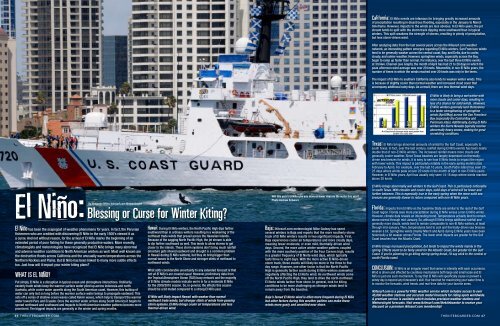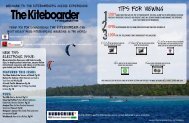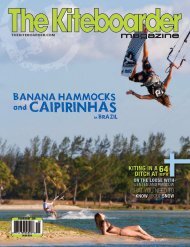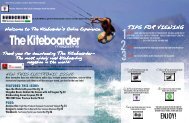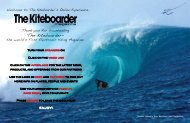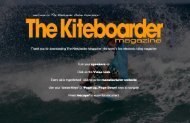TIPS FOR VIEWING - The Kiteboarder Magazine
TIPS FOR VIEWING - The Kiteboarder Magazine
TIPS FOR VIEWING - The Kiteboarder Magazine
Create successful ePaper yourself
Turn your PDF publications into a flip-book with our unique Google optimized e-Paper software.
California: El Niño events are infamous for bringing greatly increased amounts<br />
of precipitation resulting in disastrous flooding, especially in the January to March<br />
timeframe. However, impacts to the winds are less obvious. In El Niño years, the jet<br />
stream tends to split with the storm track dipping more southward than in typical<br />
winters. This split weakens the strength of storms, resulting in plenty of precipitation,<br />
but less storm-driven wind.<br />
After analyzing data from the last several years across the iKitesurf.com weather<br />
network, an interesting pattern emerges regarding El Niño winters. San Francisco winds<br />
tend to be generally weaker across the central coast, Bay, and Delta, due to cooler,<br />
cloudy, and rainier weather. However, springtime winds, especially across the Bay,<br />
begin to ramp up faster than normal. For instance, over the last three El Niño events<br />
at 3rd Ave. Channel (see Graph), the month of April has had 21 to 28 days in which the<br />
peak afternoon wind average was over 20 knots. Meanwhile, in non-El Niño years, the<br />
number of times in which the winds reached over 20 knots was only in the teens.<br />
<strong>The</strong> impact of El Niño to southern California also tends to weaken winter winds. This<br />
is because of slightly cooler than normal weather and increased cloud cover that<br />
accompany additional rainy days. As a result, there are less thermal wind days.<br />
El Niño is likely to bring a wet winter with<br />
more clouds and cooler days, resulting in<br />
less of a chance for solid winds. However,<br />
El Niño winters generally lend themselves<br />
to a faster strengthening of springtime<br />
winds (April/May) across the San Francisco<br />
Bay (especially the Central Bay and<br />
Peninsula sites). Additionally, during El Niño<br />
winters the Sierra Nevada typically receive<br />
abnormally heavy snows, making for great<br />
snowkiting conditions.<br />
Texas: El Niño brings abnormal amounts of rainfall to the Gulf Coast, especially to<br />
south Texas. In fact, over the last century, rainfall during El Niño events has been nearly<br />
double that of non-El Niño winters. <strong>The</strong> increased rainfall means more clouds and<br />
generally cooler weather. Since Texas beaches are largely dependant on thermallydriven<br />
sea breezes for winds, it is easy to see how El Niño tends to impact the region<br />
with lower winds. This impact is particularly notable in the early spring months (late<br />
February to April). For example, over the last 10 years, South Padre Island has seen 20-<br />
25 days where winds peak at over 20 knots in the month of April in non-El Niño years.<br />
However, in El Niño years, April has usually only seen 14-16 days where winds reached<br />
above 20 knots.<br />
El Niño:<br />
By Benjamin Miller, Ikitesurf.com Meteorologist<br />
Blessing or Curse for Winter Kiting?<br />
El Niño has been the scapegoat of weather phenomena for years. In fact, the Peruvian<br />
fishermen who are credited with discovering El Niño in the early 1500’s viewed it as<br />
a curse. And not without reason, for the arrival of El Niño marks the beginning of an<br />
extended period of poor fishing for these generally productive waters. More recently,<br />
climatologists and meteorologists have recognized that El Niño brings many abnormal<br />
and adverse weather conditions to North American winters as well. Most well known are<br />
the destructive floods across California and the unusually warm temperatures across the<br />
Northern Rockies and Plains. But El Niño has been linked to many more subtle effects<br />
too. Just how will it impact your winter kiting plans?<br />
WHAT IS EL NIÑO?<br />
Put simply, El Niño is a disruption in typical ocean and atmosphere interactions. Ordinarily,<br />
easterly trade winds keep the warmer surface water piled up across Indonesia and north<br />
Australia, while cooler water upwells along the South American coast. However, this buildup of<br />
water can only last so long before the warmer surface water beings to propagate eastward. This<br />
sets off a series of shallow ocean waves called Kelvin waves, which help to transport the warmer<br />
water toward Peru and Ecuador. Once the warmer water arrives along South America it begins to<br />
spread northward and southward and impacts to North American weather patterns become more<br />
prominent. <strong>The</strong> biggest impacts are generally in the winter and spring months.<br />
46 thekiteboarder.com<br />
Hawaii: During El Niño winters, the North Pacific High dips farther<br />
southward than in ordinary winters resulting in a weakening of the<br />
northeast trade winds that prevail across the Hawaiian Islands.<br />
Because of the sagging North Pacific High, the jet stream is able<br />
to dip farther southward as well. This tends to allow storms to get<br />
closer to the islands. <strong>The</strong>se storm systems don’t bring much rainfall<br />
(moisture gets shoved eastward and drought is a common problem<br />
in Hawaii during El Niño winters), but they do bring bigger than<br />
normal waves to the North Shore and stronger stints of northeast to<br />
northwest winds.<br />
What adds considerable uncertainty to any extended forecast is that<br />
not all El Niño’s are created equal. However, preliminary data from<br />
the Tropical Atmosphere Ocean (TAO) buoy network and the majority<br />
of El Niño climate models indicate we’re in for a moderate El Niño<br />
for the 2009/2010 season. So, in general, the effects this season<br />
should be a bit muted compared to a strong El Niño year.<br />
El Niño will likely impact Hawaii with weaker than normal<br />
northeast trade winds, but stronger stints of winds from passing<br />
storm systems. El Niño brings cooler air temperatures and less<br />
thermal-driven wind.<br />
Will this year’s El Niño give you more or fewer days on the water this year?<br />
Photo Andrew Schwarz<br />
Baja: iKitesurf.com meteorologist Mike Godsey has spent<br />
several winters in Baja and reports that the more southerly storm<br />
track of El Niño winters results in two significant impacts. First,<br />
Baja experiences cooler air temperatures and more cloudy days,<br />
meaning fewer moderate, or even mild, thermally-driven wind<br />
days. Second, the more active winter weather pattern, coupled<br />
with the more southerly position of the Four Corners high, results<br />
in a greater frequency of El Norte wind days, which typically<br />
lasts three to eight days. With the more active El Niño-driven<br />
storm track, these events will likely be more in the three to five<br />
day range. However, one other factor is that the North Pacific<br />
High is generally farther south during El Niño winters somewhat<br />
negatively affecting the El Norte wind. As northwest winds come<br />
off the North Pacific High, they tend to drive the north-northeast<br />
El Norte winds farther from shore. In general, look for kiting<br />
conditions to be more challenging as stronger winds tend to<br />
remain away from the beaches.<br />
Baja’s famed El Norte wind is often more frequent during El Niño<br />
but other factors during this weather pattern can make these<br />
winds more gusty and unsettled near shore.<br />
El Niño brings abnormally wet winters to the Gulf Coast. This is particularly noticeable<br />
in south Texas. With cloudier and cooler days, solid days of wind will be fewer and<br />
farther between. This is especially true in the early spring when the more solid sea<br />
breezes are generally slower to return compared with non-El Niño years.<br />
Florida: Impacts from El Niño on the Sunshine State are similar to the rest of the Gulf<br />
Coast region. Florida sees more precipitation during El Niño versus a non-El Niño winter.<br />
However, climate data reveals an interesting trend. Temperatures actually tend to remain<br />
above normal through mid-January. So, although El Niño brings additional rainfall and<br />
generally more clouds, winds tend to remain comparable to non-El Niño winters, at least<br />
through mid-January. <strong>The</strong>n, temperatures tend to cool and thermally-driven sea breezes<br />
weaken a bit. Springtime winds (mainly March and April) during El Niño years have been<br />
historically a bit weaker across Florida. <strong>The</strong> lower wind impacts are greater for the Gulf<br />
Coast beaches than the Atlantic Coast.<br />
El Niño brings increased precipitation, but tends to impact the winds mainly in the<br />
spring. Effects seem to be fairly small for the Atlantic Coast, but greater for the Gulf<br />
Coast. If you’re planning to go kiting during spring break, I’d say stick to the central or<br />
south Florida coast.<br />
CONCLUSION: El Niño is an irregular event that varies in intensity with each occurrence.<br />
Wind is driven and effected by countless mechanisms both large and small scale and El<br />
Niño is just one such mechanism. To say that El Niño will specifically cause or prevent a<br />
windy day is beyond any forecaster’s skill. Your best bet for maximizing your water time is<br />
to monitor the forecasts, wind trends, and real-time data for your favorite areas.<br />
iKitesurf.com is a powerful FREE weather service which includes access to over<br />
45,000 weather stations and accurate model forecasts for riding spots worldwide.<br />
A premium service is available which includes precision weather stations and<br />
Meteorologist forecasts. Visit www.ikitesurf.com/thekiteboarder to receive your<br />
discount on a premium ikitesurf.com membership!<br />
thekiteboarder.com 47


